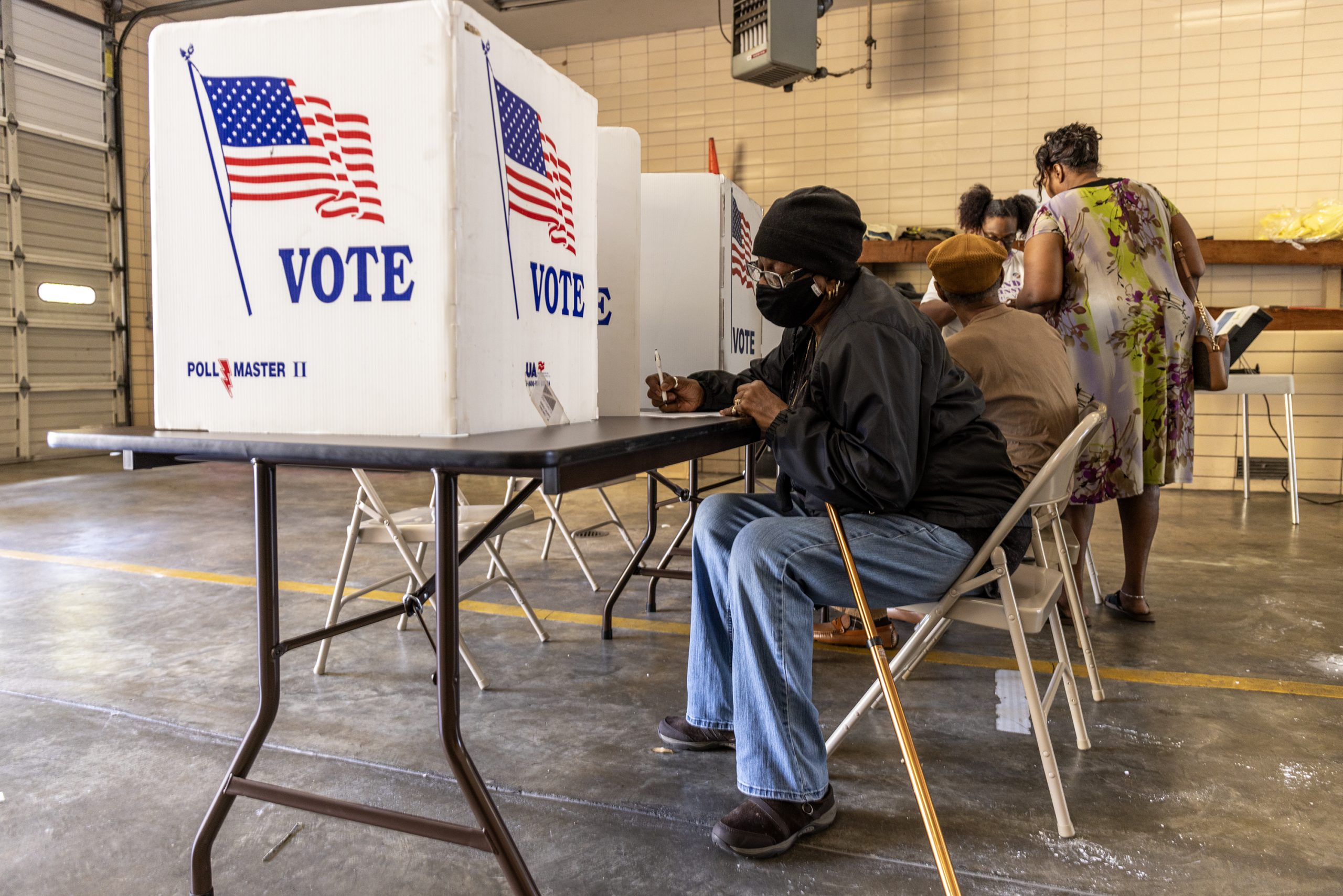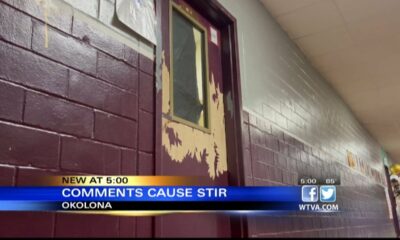Mississippi Today
How to watch the Mississippi governor’s race results like a political pro

Mississippians cast their votes Tuesday in the contentious governor's race between Gov. Tate Reeves and Democratic challenger Brandon Presley.
Independent candidate Gwendolyn Gray, who dropped out of the race in early October, withdrew too late to be removed from the ballot. Her candidacy could force the first gubernatorial runoff in the state's history.
Mississippi Today's political team compiled key themes to watch tonight as the results come in.
LIVE RESULTS: Mississippi's general election 2023
Will there be a runoff?
Pre-election polling from both Democrats and Republicans showed Reeves right at or just under earning 50% of the vote. If Gray, the independent candidate, earned enough of a protest vote on Tuesday, the top two vote-getters will face each other in a Nov. 28 runoff election.
The number to watch here is between 3% and 4%. One Republican consultant shared with Mississippi Today that they believe if Gray gets at least 3% of the overall statewide vote, it could be enough to keep Reeves or Presley under 50% and force a runoff. A second Republican consultant said it may take 4% support for Gray to force a runoff.
In 2019, there were two third-party candidates who ran against Reeves, the Republican nominee, and Jim Hood, the Democratic nominee. Together, those two third-party candidates only garnered 1.3% of the overall vote.
Did Reeves get enough conservative support?
Reeves this cycle notably struggled with firing up voters of the Republican Party's most conservative wing.
If counties that are considered conservative strongholds turn out in numbers equal to or better than 2019, this could be a sign that Reeves has weathered struggles with GOP voter enthusiasm.
Jones County, considered by many the state's capital of the far-right conservative movement, is a bellwether here. In 2019, Reeves earned 13,784 votes in Jones County — 65% of the county's total 21,257 residents who cast ballots. If Reeves gets anything less than 13,784 votes today, that could be a sign of lower-than-needed conservative support.
Pearl River County, another strongly conservative locale, is another to watch. In 2019, Reeves earned 10,083 votes here — 77% of the county's total 13,151 residents who cast ballots. It looks like 10,000 is the magic number for Reeves here, and anything less could show broader problems among Mississippi conservatives.
Did Presley get enough Black voter support?
Presley, if he has any chance of winning or forcing Reeves to a runoff, needs high levels of Black voter support. He has spent 2023 earnestly trying to earn that support, and numerous Black local elected officials have served as his surrogate for months.
Hinds County, of course, is the most critical county in this regard. It's the most populous county in the state, and it's 69% Black. In 2019, Hood, the Democrat, beat Reeves here by 56 points (78% to 22%). Hood beat Reeves in Hinds County by 40,527 votes — by far the largest head-to-head defeat in that election.
If Presley has upped that Hinds County margin of victory today, that could be enough to vault the Democrat's campaign.
Of major note in Hinds County tonight: There were reports of at least nine precincts across the county that ran out of ballots at various points during the day. Multiple lawsuits were filed attempting to extend precinct hours, and less than an hour before the schedule 7 p.m. polling close time, a chancery judge extended the hours at some precincts.
The Gulf Coast battleground
The populous three counties of the Gulf Coast, by many accounts, secured Reeves' victory in 2019 as he ran up a more than 22,400 vote margin over Hood. Reeves' margin of victory in those three counties was about half of his overall margin of victory statewide.
Reeves topped Hood by 18 points in the second-most populous Harrison County. The Coast is a Republican stronghold, but even by that measure Hood performed poorly in turning out Coast Democrats.
Presley and his campaign have worked hard on the Coast, and focused on turning out Black voters in North Gulfport and Turkey Creek in Harrison County, Moss Point in Jackson County, and other relatively large Democratic areas.
Presley stands little chance of winning the Republican-majority Coast, but if he can substantially reduce Reeves' margin there he can remain competitive statewide.
How do suburban voters swing?
Presley's campaign has also targeted voters in suburban counties that typically vote Republican but have trended more toward Democrats in recent years.
In 2019, Reeves shellacked Hood by 23 points — or nearly 8,600 votes — in the state's third-most populous DeSoto County. While DeSoto remains strongly Republican leaning, its growing population has shifted to include a larger Black voting age population more likely to vote Democratic. Plus, Presley has performed well there in his district runs for Public Service Commissioner, and his campaign this cycle has focused much effort, including a get-out-the-vote ground game, in DeSoto County. It's highly unlikely Presley could win DeSoto, but cutting losses drastically compared to those Hood suffered there would be something of a victory in an area where Reeves ran up his margin four years ago.
Rankin County, Reeves' home county and the largest suburban county in the Jackson metro, is another one to watch. In 2019, Reeves won 29,861 votes in Rankin County — 64% of the county's total 46,654 residents who cast ballots. Presley likely has no hopes of flipping this county, but watch for a smaller Reeves margin of victory in Rankin County. If the margin is less than 16,793 votes, that could be a sign that Presley's strategy to appeal to moderates worked some.
Staying in the Jackson metro area, don't forget about Madison County, which was a bright spot for Democrats in 2019. Hood garnered 19,670 votes or 50.4% to become the first Democrat since 1987 to win Madison County. Reeves won 48.7% of the vote in 2019. If Presley expects to win or force a runoff, he needs to at least match Hood's performance from 2019.
Presley's northeast Mississippi home
Another county to watch closely that could signal suburban voter support: Lee County in northeast Mississippi.
In the early 2000s, Presley served as mayor of Nettleton, which is situated on the Lee County/Monroe County line. To be successful, Presley needs to do much better in his backyard of Lee County, the most populous county in the area, than Hood did in 2019. Even though Hood is from Chickasaw County, which is contiguous to Lee, he was still swamped by Reeves in Lee County four years ago. In 2019, Reeves captured 14,672 votes or 58.3% in Lee to 10,293 or 40.9% for Hood.
Presley might not need to win Lee County to win or force a runoff, but he needs to do much better than Hood did in 2019. Needless to say, Presley needs to outperform Hood's 2019 effort throughout northeast Mississippi.
This article first appeared on Mississippi Today and is republished here under a Creative Commons license.
Mississippi Today
Federal panel prescribes new mental health strategy to curb maternal deaths

For help, call or text the National Maternal Mental Health Hotline at 1-833-TLC-MAMA (1-833-852-6262) or contact the 988 Suicide & Crisis Lifeline by dialing or texting “988.” Spanish-language services are also available.
BRIDGEPORT, Conn. — Milagros Aquino was trying to find a new place to live and had been struggling to get used to new foods after she moved to Bridgeport from Peru with her husband and young son in 2023.
When Aquino, now 31, got pregnant in May 2023, “instantly everything got so much worse than before,” she said. “I was so sad and lying in bed all day. I was really lost and just surviving.”
Aquino has lots of company.
Perinatal depression affects as many as 20% of women in the United States during pregnancy, the postpartum period, or both, according to studies. In some states, anxiety or depression afflicts nearly a quarter of new mothers or pregnant women.
Many women in the U.S. go untreated because there is no widely deployed system to screen for mental illness in mothers, despite widespread recommendations to do so. Experts say the lack of screening has driven higher rates of mental illness, suicide, and drug overdoses that are now the leading causes of death in the first year after a woman gives birth.
“This is a systemic issue, a medical issue, and a human rights issue,” said Lindsay R. Standeven, a perinatal psychiatrist and the clinical and education director of the Johns Hopkins Reproductive Mental Health Center.
Standeven said the root causes of the problem include racial and socioeconomic disparities in maternal care and a lack of support systems for new mothers. She also pointed a finger at a shortage of mental health professionals, insufficient maternal mental health training for providers, and insufficient reimbursement for mental health services. Finally, Standeven said, the problem is exacerbated by the absence of national maternity leave policies, and the access to weapons.
Those factors helped drive a 105% increase in postpartum depression from 2010 to 2021, according to the American Journal of Obstetrics & Gynecology.
For Aquino, it wasn't until the last weeks of her pregnancy, when she signed up for acupuncture to relieve her stress, that a social worker helped her get care through the Emme Coalition, which connects girls and women with financial help, mental health counseling services, and other resources.
Mothers diagnosed with perinatal depression or anxiety during or after pregnancy are at about three times the risk of suicidal behavior and six times the risk of suicide compared with mothers without a mood disorder, according to recent U.S. and international studies in JAMA Network Open and The BMJ.
The toll of the maternal mental health crisis is particularly acute in rural communities that have become maternity care deserts, as small hospitals close their labor and delivery units because of plummeting birth rates, or because of financial or staffing issues.
This week, the Maternal Mental Health Task Force — co-led by the Office on Women's Health and the Substance Abuse and Mental Health Services Administration and formed in September to respond to the problem — recommended creating maternity care centers that could serve as hubs of integrated care and birthing facilities by building upon the services and personnel already in communities.
The task force will soon determine what portions of the plan will require congressional action and funding to implement and what will be “low-hanging fruit,” said Joy Burkhard, a member of the task force and the executive director of the nonprofit Policy Center for Maternal Mental Health.
Burkhard said equitable access to care is essential. The task force recommended that federal officials identify areas where maternity centers should be placed based on data identifying the underserved. “Rural America,” she said, “is first and foremost.”
There are shortages of care in “unlikely areas,” including Los Angeles County, where some maternity wards have recently closed, said Burkhard. Urban areas that are underserved would also be eligible to get the new centers.
“All that mothers are asking for is maternity care that makes sense. Right now, none of that exists,” she said.
Several pilot programs are designed to help struggling mothers by training and equipping midwives and doulas, people who provide guidance and support to the mothers of newborns.
In Montana, rates of maternal depression before, during, and after pregnancy are higher than the national average. From 2017 to 2020, approximately 15% of mothers experienced postpartum depression and 27% experienced perinatal depression, according to the Montana Pregnancy Risk Assessment Monitoring System. The state had the sixth-highest maternal mortality rate in the country in 2019, when it received a federal grant to begin training doulas.
To date, the program has trained 108 doulas, many of whom are Native American. Native Americans make up 6.6% of Montana's population. Indigenous people, particularly those in rural areas, have twice the national rate of severe maternal morbidity and mortality compared with white women, according to a study in Obstetrics and Gynecology.
Stephanie Fitch, grant manager at Montana Obstetrics & Maternal Support at Billings Clinic, said training doulas “has the potential to counter systemic barriers that disproportionately impact our tribal communities and improve overall community health.”
Twelve states and Washington, D.C., have Medicaid coverage for doula care, according to the National Health Law Program. They are California, Florida, Maryland, Massachusetts, Michigan, Minnesota, Nevada, New Jersey, Oklahoma, Oregon, Rhode Island, and Virginia. Medicaid pays for about 41% of births in the U.S., according to the Centers for Disease Control and Prevention.
Jacqueline Carrizo, a doula assigned to Aquino through the Emme Coalition, played an important role in Aquino's recovery. Aquino said she couldn't have imagined going through such a “dark time alone.” With Carrizo's support, “I could make it,” she said.
Genetic and environmental factors, or a past mental health disorder, can increase the risk of depression or anxiety during pregnancy. But mood disorders can happen to anyone.
Teresa Martinez, 30, of Price, Utah, had struggled with anxiety and infertility for years before she conceived her first child. The joy and relief of giving birth to her son in 2012 were short-lived.
Without warning, “a dark cloud came over me,” she said.
Martinez was afraid to tell her husband. “As a woman, you feel so much pressure and you don't want that stigma of not being a good mom,” she said.
In recent years, programs around the country have started to help doctors recognize mothers' mood disorders and learn how to help them before any harm is done.
One of the most successful is the Massachusetts Child Psychiatry Access Program for Moms, which began a decade ago and has since spread to 29 states. The program, supported by federal and state funding, provides tools and training for physicians and other providers to screen and identify disorders, triage patients, and offer treatment options.
But the expansion of maternal mental health programs is taking place amid sparse resources in much of rural America. Many programs across the country have run out of money.
The federal task force proposed that Congress fund and create consultation programs similar to the one in Massachusetts, but not to replace the ones already in place, said Burkhard.
In April, Missouri became the latest state to adopt the Massachusetts model. Women on Medicaid in Missouri are 10 times as likely to die within one year of pregnancy as those with private insurance. From 2018 through 2020, an average of 70 Missouri women died each year while pregnant or within one year of giving birth, according to state government statistics.
Wendy Ell, executive director of the Maternal Health Access Project in Missouri, called her service a “lifesaving resource” that is free and easy to access for any health care provider in the state who sees patients in the perinatal period.
About 50 health care providers have signed up for Ell's program since it began. Within 30 minutes of a request, the providers can consult over the phone with one of three perinatal psychiatrists. But while the doctors can get help from the psychiatrists, mental health resources for patients are not as readily available.
The task force called for federal funding to train more mental health providers and place them in high-need areas like Missouri. The task force also recommended training and certifying a more diverse workforce of community mental health workers, patient navigators, doulas, and peer support specialists in areas where they are most needed.
A new voluntary curriculum in reproductive psychiatry is designed to help psychiatry residents, fellows, and mental health practitioners who may have little or no training or education about the management of psychiatric illness in the perinatal period. A small study found that the curriculum significantly improved psychiatrists' ability to treat perinatal women with mental illness, said Standeven, who contributed to the training program and is one of the study's authors.
Nancy Byatt, a perinatal psychiatrist at the University of Massachusetts Chan School of Medicine who led the launch of the Massachusetts Child Psychiatry Access Program for Moms in 2014, said there is still a lot of work to do.
“I think that the most important thing is that we have made a lot of progress and, in that sense, I am kind of hopeful,” Byatt said.
Cheryl Platzman Weinstock's reporting is supported by a grant from the National Institute for Health Care Management Foundation. KFF Health News is a national newsroom that produces in-depth journalism about health issues and is one of the core operating programs at KFF—an independent source of health policy research, polling, and journalism. Learn more about KFF.
This article first appeared on Mississippi Today and is republished here under a Creative Commons license.
Did you miss our previous article…
https://www.biloxinewsevents.com/?p=359245
Mississippi Today
New law gives state board power to probe officer misconduct
The state's officer certification and training board now has the power to investigate law enforcement misconduct.
Gov. Tate Reeves signed the bill making it official.
Public Safety Commissioner Sean Tindell, who pushed for the legislation, said that House Bill 691 authorizes the Board of Law Enforcement Officer Standards and Training “to launch its own investigations into officer misconduct. This change, along with the funding to hire two investigators, will improve the board's ability to ensure officer professionalism and standards.”
The new law comes in the wake of an investigation by the Mississippi Center for Investigative Reporting at Mississippi Today and The New York Times into sheriffs and deputies across the state over allegations of sexual abuse, torture and corruption.
Tindell said the new law will “improve law-enforcement training in Mississippi by requiring all law enforcement officers to receive continuing training throughout an officer's career.”
Under that law, deputies, sheriffs and state law enforcement officers will join police officers in the requirement to have up to 24 hours of continuing education training. Those who fail to train could lose their certifications.
Other changes will take place as well. Each year, the licensing board will have to report on its activities to the Legislature and the governor.
Tindell thanked Reeves “for signing this important piece of legislation and the legislative leaders who supported its passage, including the author of HB 691, Representative Fred Shanks.”
Shanks, R-Brandon, praised the “team effort with some very smart people who want a top-notch law enforcement community.”
The new law creates a 13-member board with the governor having six appointments – two police chiefs, two sheriffs, a district attorney and the director of the Mississippi Law Enforcement Officers' Training Academy.
Other members would include the attorney general or a designee, the director of the Mississippi Highway Patrol, the public safety commissioner and the presidents of the Mississippi Association of Chiefs of Police, the Mississippi Constable Association, the Mississippi Campus Law Enforcement Association and the Mississippi Sheriffs' Association (or their designees).
“We obviously need checks and balances on how law enforcement officers conduct themselves,” said state Sen. John Horhn, D-Jackson. “This is a good first step.”
This article first appeared on Mississippi Today and is republished here under a Creative Commons license.
Mississippi Today
Lawmakers punt to next year efforts to expand college aid for low-income Mississippians
A bill to open a college financial aid program for the first time ever to Mississippians who are adult, part-time and very low-income students fell to the wayside in a legislative session dominated by fights over Medicaid and K-12 funding.
The effort to expand the Mississippi Resident Tuition Assistance Grant, called MTAG, died in conference after it was removed from House Bill 765, legislation to provide financial assistance to teachers in critical shortage areas. The Senate had attached MTAG's code sections to that bill in an attempt to keep the expansion alive.
This takes Jennifer Rogers, the director of the Mississippi Office of Student Financial Aid, back to the drawing board after years of championing legislation to modernize the way the state helps Mississippians pay for college.
“At the end of the day, there was no appetite to spend any additional money on student financial aid,” Rogers said. “Obviously, I'm disappointed.”
All told, the original proposal would have resulted in the state spending upwards of $30 million extra each year, almost doubling OSFA's roughly $50 million budget.
The increase derived from two aspects of the proposal: An estimated 37,000 Mississippians who have never been eligible for college financial aid would have become eligible to receive it, and the scholarship amounts would have increased.
While college students from millionaire families can get MTAG, the state's poorest students are not eligible, Mississippi Today previously reported.
Rep. Kent McCarty, R-Hattiesburg, said he supports efforts to help low-income Mississippians afford college, but that HB 765 was not an appropriate vehicle to do so because it was not an appropriations bill. Attempting to expand MTAG through that legislation would have put the original subject of HB 765, the Mississippi Critical Teachers Shortage Act, at risk.
“We didn't feel it was appropriate to include an appropriation in a bill that had not been through the appropriations process,” he said.
McCarty, a member of the House Universities and Colleges Committee, added that he is in favor of changing MTAG and doesn't understand the logic behind excluding from state financial aid Mississippi college students who receive a full federal Pell Grant, meaning they come from the state's poorest families.
“What is the purpose of financial aid? To aid those who need financial aid,” he said. “Excluding a group of students because they're eligible for other financial aid doesn't make a lot of sense to me.”
Ultimately, the Mississippi House deemed the proposal too expensive. It never passed out of that chamber's Appropriations Committee.
READ MORE: ‘A thing called money:' Bill to expand financial aid stalled after House lawmakers balk at price tag
Rogers said she plans to work with lawmakers to convince them that it is a good use of state dollars to invest in financial aid. She added that the support of the business community helped keep the bill alive as long as it did this session. The Mississippi Economic Council supported the legislation.
“I don't understand why there is such a hesitancy to invest more in the future workforce of the state,” she said. “I don't understand why there isn't a willingness to invest in student financial aid as a way to help more Mississippians complete meaningful certificates or degrees, valuable certificates or degrees and improve the quality of the workforce.”
Senate Education Committee Chairman Dennis DeBar, R-Leakesville, told Mississippi Today that he hopes to take a closer look at MTAG this summer, noting that the Senate's version of the proposal, which also included a last-dollar tuition scholarship, was a priority of the lieutenant governor on last year's campaign trail.
“We had so many issues last session,” DeBar said. “Hopefully there won't be as many next year so we can just focus this year and get it across the finish line.”
This article first appeared on Mississippi Today and is republished here under a Creative Commons license.
-
SuperTalk FM4 days ago
Martin Lawrence making 3 stops in Mississippi on comedy tour
-
Our Mississippi Home3 days ago
Beat the Heat with Mississippi’s Best Waterparks
-
Mississippi Today6 days ago
Lawmakers may have to return to Capitol May 14 to override Gov. Tate Reeves’ potential vetoes
-
Our Mississippi Home3 days ago
Charlie’s U-Pik: Opening Soon for the Summer Season
-
Mississippi News Video6 days ago
Local dentists offer free dental care in Amory
-
Kaiser Health News3 days ago
Medicaid ‘Unwinding’ Decried as Biased Against Disabled People
-
Mississippi News6 days ago
Bond set for West Point couple accused of killing their child
-
Mississippi News Video2 days ago
Jackson has a gang problem




























![HIGH SCHOOL SOFTBALL: Vancleave @ East Central (5/9/2024) [5A Playoffs, South State]](https://www.biloxinewsevents.com/wp-content/uploads/2024/05/1715460379_maxresdefault-80x80.jpg)






